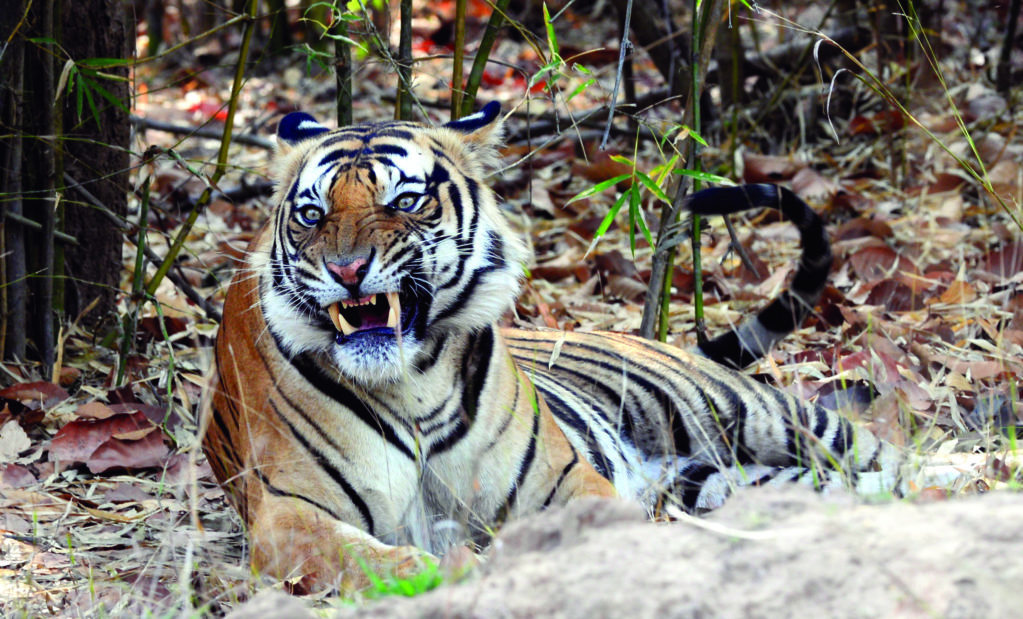The tiger has always played a part in our collective consciousness, often interpreted as a symbol of power, strength and beauty. In Hindu culture, the tiger is revered as the sacred vehicle of Durga, the warrior goddess.
And I had the opportunity to come face-to-face with this mighty animal on a recent trip through the forests of central India where a majority of them still roam.
I arrived at the Bandhavgarh National Park (BNP), in the Indian state of Madhya Pradesh, by plane from New Delhi, landing in Jabalpur and then by car to the park; a journey of 600 miles to visit the home of an animal that has existed for two million years.
Known to have evolved from the saber-toothed cat that lived 32 million years ago, tigers have spread from their original home in China and evolved into many subspecies including the Royal Bengal Tiger of India. The BNP was the hunting preserve of the rulers of the state in the 1800s and has hosted many hunters from the British Raj; it has documented killings of over 350 cats by one particular hunter during his five-year posting in India. At the close of the 19th century, when Rudyard Kipling penned The Jungle Book, some 50,000 to 100,000 tigers were thought to roam the Indian subcontinent.
The tiger once ranged widely across Asia, from Anatolian Turkey in the west to Kamchatka, in the eastern coast of Russia; over the past 100 years tigers have disappeared from southwest and central Asia. According to the World Wildlife Fund (WWF), tigers inhabit less than 6% of their historic range with a 42% decline since 2006. Breeding populations of tigers are currently found in eight range states: Bangladesh, Bhutan, India, Indonesia, Malaysia, Nepal, Russia, and Thailand.
Since 1900, the number of tigers in the wild has shrunk from an estimated 100,000 to as few as 3,200. WWF is working toward a bold but achievable goal to double the number of tigers in the wild by 2022, the next Year of the Tiger. A 2015 news report reveals healthy population increases in all ranges in south and central India.
Strictly-managed and controlled jeep safaris are the only way one can encounter these magnificent animals in their natural habitat. My first encounter on my trip was with a mother and her three grown cubs that paced majestically through the sal tree forest, disappearing often into the high grass that grows after the monsoons.
This was the beginning of a four-day, 32-hour photographic ‘hunt’ for these animals. Sighting and photographing seven of them was not easy since they are primarily active in the wee hours, returning after a hunt, or during dusk before a hunt. Being solitary animals and effectively camouflaged, tracking them is one of the great joys and challenges of wildlife photography.
BNP allows a maximum of 32 jeeps per day in two four-hour windows. This capacity control was established by Project Tiger, an Indian initiative to protect the tigers. The park has a huge variety of mammals such as black bears, antelopes, deer, reptiles including crocodiles and snakes, and over 350 species of birds.
At 6AM on a cold morning, I was filled with excitement when I spotted a young male tiger, looking tired and hungry after an unsuccessful night of hunting. He approached my jeep from 600 feet away, oblivious to my presence and walked within a few feet marking his territory along the way.
Tigers need to kill 60-75 large prey animals per year. They are opportunistic predators, however, their diet includes birds, fish, rodents, insects, amphibians and reptiles in addition to other mammals such as primates and porcupines. Tigers can also take ungulate prey much larger than themselves, including the water buffalo, Indian bison, small elephants and on occasion even rhinos. Bandhavgarh boasts all of the above animals except the rhino and elephant which are distributed further north in Chitwan Park near the border with Nepal, another known tiger range.
On my last evening, after patiently waiting near a waterhole for two hours, I was rewarded with a large male tiger emerging from the bamboo thicket to drink water barely 15 feet away. His majesty made for some amazing pictures. I left Bandhavgarh and my lovely lodge with a heavy heart knowing that this tiger could be the victim of poachers any time.
National Geographic reports that it is rarely poor locals who are poaching the tigers – it’s organized gangs.
“Tigers are part of a massive wildlife trade that’s run by sophisticated international crime syndicates, the same trade that’s wiping out elephants, rhinos and so many other species. It’s a $19-billion-a-year business,” quotes the magazine.
These majestic cats are being slaughtered across India and the entire Southeast Asian range, mostly for their bones and magnificent pelts. Smuggled into China for use in expensive traditional tonics, tiger bones are thought to impart the animal’s great energy and strength. In addition, across their entire distribution, tigers face unrelenting pressure from retaliatory killings by farmers and habitat loss. They are forced to compete for space with an ever-growing human population.
Alas, in the end, it would seem their fate is no different from their fierce, feline and equally-famous cousin – the African lion.
